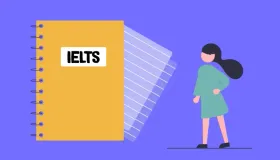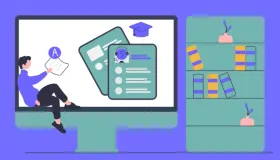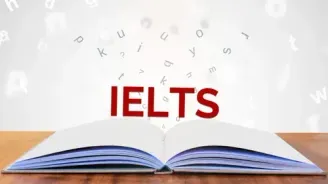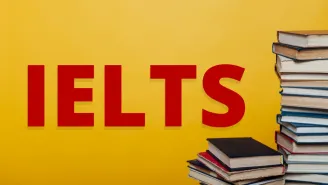E Learning Reading Answer Passage
E Learning Reading Answer Passage
Paragraph A. Corporate e-learning can greatly benefit from the fact that e-learning is the word that unites the domains of online learning, web-based training, and technology-delivered instruction. For instance, IBM claims that the implementation of their online manager training program, Basic Blue, saved the corporation somewhere between $200 million and $300 million in 1999. The majority of the savings come from eliminating the need for employees and instructors to travel to a single classroom. Employees can learn from any Internet-connected PC, wherever in the world, with an online course. Ernst and Young increased consistency and scalability while cutting training expenditures by 35%.
Paragraph B. E-learning has become a top priority for many organisations due to its many advantages, including convenience, uniform delivery, self-paced learning, and a range of available information, in addition to its generally advantageous economic effects. Many people assume that e-learning provides flexible, "any time, any place" learning. The assertion that "any place" is true is a fantastic development and is valid in theory. Rich learning resources are now accessible to many more people than they were in the paper or broadcast distance learning era. E-training has enormous potential for teaching certain knowledge and abilities. It can be particularly useful for assisting staff members in their preparation for IT certification courses. Additionally, it appears that e-learning can effectively address issues like management training, safety training, and sexual harassment education5, all of which have a defined set of objectives. Finally, training professionals advise using a "blended" strategy that alternates between online and in-person training as needed. E-learning is not a magic bullet. However, it has benefits if they help reduce costs and windowless classrooms full of snoring kids.
Paragraph C. The technology has received a lot of attention in the debate on how to deploy e-learning, but as Driscoll and others have pointed out, there are many other human variables to consider as well. Any competent manager is aware of the importance of training staff members to ensure a successful firm. Despite this, traditional classroom training carries the danger of being pricy, cumbersome, and frequently unsuccessful. The fact that the classroom requires individuals to leave their employment is possibly its biggest drawback. Each minute an employee spends in a classroom learning is a minute they are not working on the shop floor. Now, it appears as though there is a technique to get over these limitations of conventional training. With the goal of allowing each student to learn at their own pace, e-training offers more effective teaching methods by incorporating audio, video, animation, text, and interactive materials. Along with improved performance outcomes, students also immediately benefit from increased task retention, higher motivation, and a reduction in test anxiety for many students. According to a California State University Northridge research, e-learners outperformed traditional learners by 20%. Nelson found a substantial difference in performance between 406 university students who took traditional and online education courses, with the latter group outperforming the former.
Paragraph D. However, no one ever claimed that E-training technology would be affordable. On average, e-training service providers charge between $10,000 and $60,000 to create one hour of online education. The cost varies according to the difficulty of the training subject and the media employed. As opposed to flash animations or streaming video, HTML sites are a little less expensive to create. Cost is only the beginning when it comes to course content. The technological foundation is also a part of a whole e-learning solution (the computers, applications and network connections that are used to deliver the courses). A learning management system (LMS) is a type of technology platform that can be installed on-site or outsourced. You're left with a hefty fee after factoring in the costs of the network bandwidth investments required to provide multimedia courses. The first year's costs for the LMS infrastructure and a dozen or more online courses can reach $500,000 or more. Custom e-training is now only a possibility for large enterprises due to these kinds of expenditures. The e-training idea pays for itself for businesses with a big enough workforce. Large corporations are making significant investments in online training in light of this fact. More than half of Rockwell Collins' 400+ courses are now given directly to customers in an e-learning format, cutting the company's yearly training expenditures by 40%. There are plenty of such success tales.
Paragraph E. The classroom isn't anticipated to be completely replaced by e-learning. One of the problems with delivering multimedia over the Internet is still bandwidth restrictions. E-training isn't appropriate for every form of instruction or subject, as well. For instance, establishing teams or transferring cultural values is relatively ineffective. It would be challenging to explain your company's distinctive corporate culture to new hires over a computer monitor. For these goals, group training sessions are more suitable. Because of the time spent creating and instructing online courses, there is also a perceived loss of research time. Between 500 and 1,000 person-hours, or Wallin-hours, according to Professor Wallin, were needed to maintain the course's relevance and usefulness. (Despite the sophistication of the courseware system, distance learning instructors frequently need technical expertise.) That is equivalent to one-fourth to one-half of a person-year. A final requirement for teaching materials is equipment and computer literacy. Any e-Learning system requires some fundamental tools and a working knowledge of computers in order to complete the activities specified by the system. A learner cannot complete an e-Learning program successfully if they lack these abilities or access to these resources.
Paragraph F. While there is little debate about the obvious benefits of e-learning, thorough research is required to demonstrate that students are actually learning and applying the skills they are being taught online and that e-learning is the most effective method for achieving the desired results in a corporate setting. A go-between form of blended learning, which describes the blending of several learning contexts, is becoming more and more common nowadays. It mixes conventional in-person teaching techniques with more contemporary computer-mediated activities. The technique creates a more integrated approach for teachers and learners, according to the strategy's proponents. In the past, technology-based learning tools supported in-person training. Technology will take on a bigger role through a mixed-learning approach.
Let’s explore the questions and answers of the E Learning reading answer passage.
E Learning Reading Answers with Sample Questions
Have you read the passage? Now, take the test and find E Learning Reading answers! Try to answer these questions by yourself before you sneak a peek at the answers given below.
Check Out Top 50+ IELTS Reading Practice Test Questions with Answers
Below are some top 50+ free IELTS Reading Practice test online questions with detailed answers to enhance your IELTS preparation online. We have provided sample passages for each test type for your reference.
- What Is Exploration Reading Answers
- Effects Of Noise Reading Answers
- The Discovery Of Baby Mammoth Reading Answers
- The Dead Sea Scrolls Reading Answers
- The Ring-Tailed Lemur Reading Answers
- Why We Need To Protect Polar Bears Reading Answers
- Nutmeg A Valuable Spice Reading Answers
- What Is Meaning Reading Answers
- Cutty Sark Reading Answers
- The Step Pyramid Of Djoser Reading Answers
- South Pole Adventurer Reading Answers
- The Future Of Work Reading Answers
- Ambergris Reading Answers
- Trees In Trouble Reading Answers
- Could Urban Engineers Learn From Dance Reading Answers
- The Flavour Of Pleasure Reading Answers
- The Value Of A College Degree Reading Answers
- Why You Should Delegate Tasks To Team Members Reading Answers
- Corporate Social Responsibility Reading Answers
- Forest Management In Pennsylvania USA Reading Answers
- Making Time For Science Reading Answers
- The Power Of Play Reading Answers
- Coastal Archaeology Of Britain Reading Answers
- How The Other Half Thinks Reading Answers
- Changes In Reading Habits Reading Answers
- The Forgotten Forest Reading Answers
- When Conversations Flow Reading Answers
- Attitudes Towards Artificial Intelligence Reading Answers
- The Ingenuity Gap Reading Answers
- A Bar At The Folies Reading Answers
- Booking A Wessex Cottages Holiday Reading Answers
- Sunset Tours Reading Answers
- Bird Migration Reading Answers
- Clutter Bugs Beware Reading Answers
- The Hidden Histories Of Exploration Exhibition Reading Answers
- Calisthenics Reading Answers
- Having A Lovely Time Reading Answers
- The Return Of Huarango Reading Answers
- Summer Activities At London Kew Gardens Reading Answers
- Computer Games For Preschoolers Reading Answers
- Extinct The Giant Deer Reading Answers
- Micro Enterprise Credit For Street Youth Reading Answers
- Plain English Campaign Reading Answers
- Glow Worms Reading Answers
- How To Prepare For An Interview Reading Answers
- Quiet Roads Ahead Reading Answers
- Sculpture Reading Answers
- Cornwall Reading Answers
- Latchkey Children Reading Answers
- Healthy Intentions Reading Answers
- Makete Integrated Rural Transport Project Reading Answers
- Allergy Testing Reading Answers
- Life Casting And Art Reading Answers
- Metropolis Movies Reading Answers
- The Bridge That Swayed Reading Answers
- The Discovery Of Uranus Reading Answers
- The Extraordinary Watkin Tench Reading Answers
- The Secret Schizoid Reading Answers
- The Sun A Mixed Blessing Reading Answers
- UK Companies Need More Effective Boards Of Directors Reading Answers
- Why Does Skin Wrinkle In Water Reading Answers
- Cleaner Abundant Ielts Reading Answers







